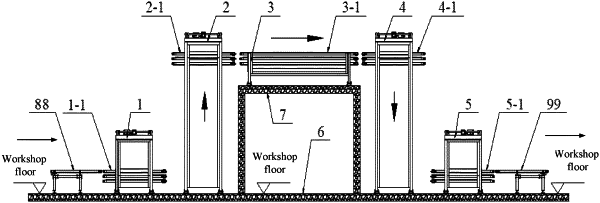| CPC B65G 49/064 (2013.01) [B65G 13/00 (2013.01)] | 20 Claims |

|
1. An avoidance conveying method for a glass production line, applied to an avoidance conveying device for the glass production line, wherein the avoidance conveying device for the glass production line comprises a receiving device, a front lifting device, a transition device, a rear lifting device, and a sending device arranged in sequence along a direction of conveying glass sheets, wherein the avoidance conveying device is set to be a symmetrical structure centered on the transition device, wherein the receiving device is configured to receive the glass sheets conveyed by a front roller conveyor of an original sheet production line; wherein the front lifting device is configured to convey the glass sheets from the receiving device to the transition device; wherein the transition device is configured to convey the glass sheets from the front lifting device to the rear lifting device; wherein the rear lifting device is configured to convey the glass sheets from the transition device to the sending device; wherein the sending device is configured to convey the glass sheets to a rear roller conveyor of the original sheet production line; wherein a first end of the front lifting device away from the transition device is a front initial position, a second end of the front lifting device close to the transition device is a front working position, a first end of the rear lifting device close to the transition device is a rear initial position, and a second end of the rear lifting device away from the transition device is a rear working position, wherein the avoidance conveying method comprises:
step S1, receiving, using the receiving device, the glass sheets conveyed by the front roller conveyor of the original sheet production line;
step S2, conveying, using the receiving device, the glass sheets on the receiving device to the front lifting device at the front initial position docked with the receiving device;
step S3, conveying, using the front lifting device, the glass sheets from the front initial position to the front working position, wherein the front lifting device runs to the front working position to dock with the transition device;
step S4, conveying the glass sheets on the front lifting device to the transition device docked with the front lifting device;
step S5, conveying, using the transition device, the glass sheets from one side of the transition device to the other side of the transition device, and conveying the glass sheets on the transition device to the rear lifting device at the rear initial position docked with the transition device;
step S6, conveying, using the rear lifting device, the glass sheets from the rear initial position to the rear working position, wherein the rear lifting device runs to the rear working position to dock with the sending device;
step S7, conveying, the glass sheets on the rear working position of the rear lifting device to the sending device docked with the rear working position; and
step S8, conveying, using the sending device, the glass sheets on the sending device to the rear roller conveyor of the original sheet production line;
wherein an avoidance channel is formed between the front lifting device and the rear lifting device, wherein the avoidance channel between the front lifting device and the rear lifting device is configured for pedestrians and forklifts to pass through the glass production line at any time, and the receiving device, the front lifting device, the transition device, the rear lifting device, and the sending device are configured to sequentially convey the glass sheets from the front roller conveyor to the rear roller conveyor of the original sheet production line to bypass the avoidance channel.
|